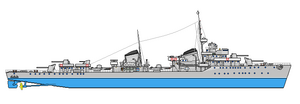Elvira-Class Destroyer
This article is incomplete because it is pending further input from participants, or it is a work-in-progress by one author. Please comment on this article's talk page to share your input, comments and questions. Note: To contribute to this article, you may need to seek help from the author(s) of this page. |

| |
| Class overview | |
|---|---|
| Name: | Elvira-class destroyer |
| Builders: | Royal Shipbuilders of Cacerta |
| Operators: |
|
| Preceded by: | Luciana-class |
| Succeeded by: | Lavinia-class |
| In commission: | 1933 – 1957 |
| Completed: | 108 |
| Lost: | 19 |
| Retired: | 89 |
| Preserved: | 2 |
| General characteristics | |
| Type: | Destroyer |
| Displacement: |
|
| Length: | 114.5 meters |
| Beam: | 10.2 meters |
| Draft: | 3.9 meters |
| Propulsion: |
|
| Speed: | 40.3 knots (74.6 km/h) |
| Range: | 5,100 nautical miles at 17 knots |
| Complement: | 271 officers and crew |
| Armament: |
|
The Elvira-class were a group of over a hundred destroyers built for the Cacertian Royal Navy beginning in 1933. They were improved versions of the preceding Luciana-class which resolved the significant structural weaknesses and mechanical issues that plagued them. Other improvements included the installation of a fourth boiler as well as a larger fuel capacity.
Along with the Vera-class, the ships of the Elvira family formed the main body of the Royal Navy’s destroyer forces during the Siduri War. The armament aboard the Elviras made it a less potent surface combatant than the Veras, but their better radar and sonar technology made them an intrinsically critical component of Cacertian fleet formations. It was common for Veras and Elviras to be in constant communication in order to complement each other during various actions.
A total of 108 Elvira-class destroyers were built between 1933 and 1938 with nineteen lost in combat. The remaining 89 remained in service until being decommissioned between 1953 and 1957.